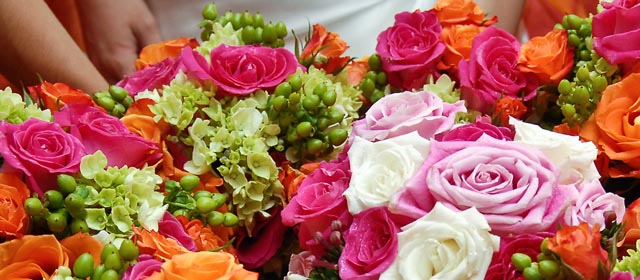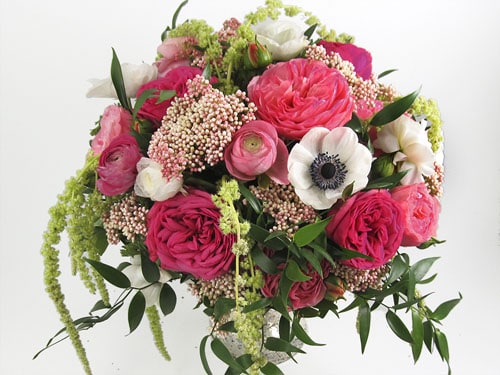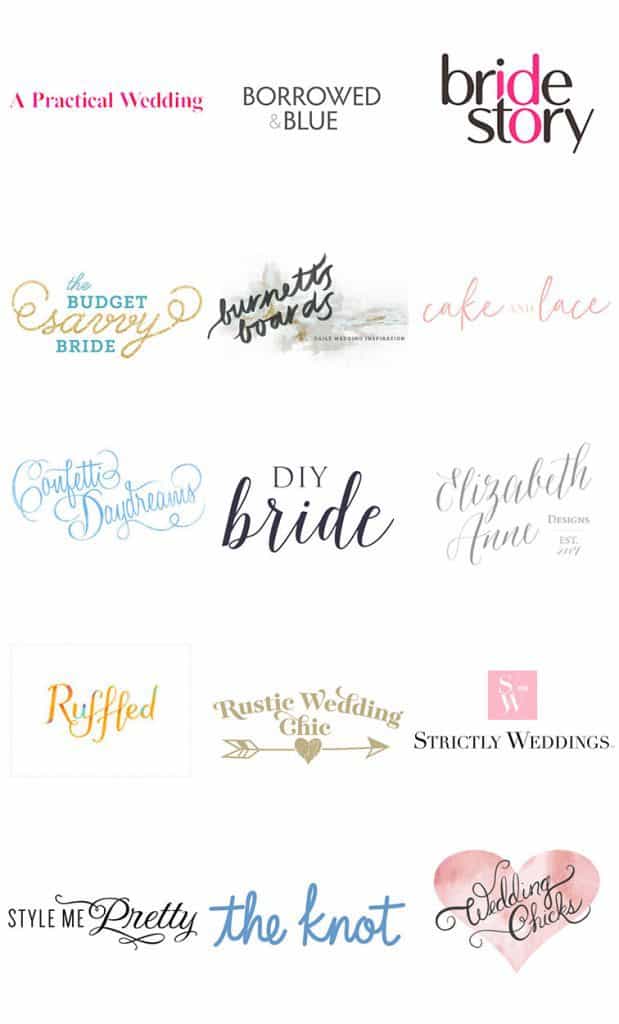Part 5 of Blooms Blog’s “What Types of Flowers Should I Use for My Wedding” Series: What Types of Flower Arrangements and Bouquets are You Making?
To help you decide what types of flowers to use for your wedding, so far we’ve covered wedding flowers by season, picking DIY-friendly flowers, and matching flowers and accents with your wedding themes. Another key question to ask is what kind of bouquets and arrangements do you want to make? Different arrangement styles are easier with certain kinds of flowers and should avoid others.
The easiest way to work through this is to make a running list of all the flower arrangements you will need for the event: bridal bouquet, bridesmaids’ bouquets, centerpieces, and ceremony flowers. Don’t forget the little areas like the cake table, your sweetheart table, buffet area, seating card table, and gift table. If it’s too much on your plate, you can always delegate the more complicated ones to a florist and just DIY the easy stuff! We get a lot of brides who prefer to have their bouquets done by professionals and leave the centerpieces, boutonnieres and smaller arrangements to themselves to make the flower arranging fun and stress-free part of the event!
Now, you don’t need to use the same flowers across all of your bouquets and arrangements. Keep your style consistent, and have some elements – kind of flowers or pops of a one or more colors repeat for a cohesive look. But you can mix and match vases and containers and other accents. This is a great money-saver, too, because you can keep the more expensive blooms to your most important arrangements (hello, bridal bouquet and groom’s bout!) and use cheaper flowers for other bouquets and centerpieces.
Flowers for Wedding Bouquets
A hand-tied wildflower bouquet is the easiest of the DIY wedding flowers and can be really easy on your budget. Start with one or two kinds of medium-to-large focal flowers like roses or dahlias, then add loose, airy fillers and greens. Here are some great combinations of wildflower wedding flowers. For a cascading bouquet, look for more relaxed fillers and greens that can give the drape you want, like amaranthus or ivy. For flowers, keep stems long on roses, and think about stock, delphinium and other flowers that bloom down the stem to make a lusher cascade. A more modern round rose bouquet is made of medium-to-large roses, tightly clustered and with little or no greenery. You can add some berries or small accent flowers within the roses for extra texture. A pageant bouquet can be a show-stopper – look for long-stemmed flowers like roses and calla lilies, and add in some cascading fillers.
Photo By: Lauren Kriedemann | Floral Design By: Green Goddess Flower Studio | Via: The Pretty Blog
The Boutonniere
Boutonnieres are the easiest of the DIY wedding flowers! There are tons of online boutonniere tutorials out there, and you can easily swap focal flowers and fillers to suit your wedding theme. Boutonnieres require smaller flowers such as spray roses, ranunculus, or chrysanthemums. Novelties such as billy balls, scabiosa pods, and thistle are also great go-to’s for a rustic or whimsical boutonniere. You’ll just want to avoid larger flowers, like peonies, garden roses, and football mums, of course, just for sheer size. Also, watch out for blooms that won’t do well without any water – don’t try to put sprigs of hydrangea or delphinium, for instance, because they’ll shrivel pretty quickly. And more delicate flowers, like waxflower, don’t always hold up well to the handling that boutonnieres tend to go through. And – don’t forget the boutonniere pins and floral tape and optional twine or ribbon to wrap around the floral tape.
Wedding Centerpieces
Traditionally, arrangements consist of focal 1-2 varieties of focal flowers (roses, garden roses, peonies, calla lilies, ranunculus, gerbera daisies, hydrangeas, dahlias, poppies, carnations), 1-2 secondary flowers (chrysanthemums, stock, spray roses, delphinium, larkspur, snapdragons, freesia, mini carnations, hypericum berries, alstroemeria, and asters), 1-2 filler flowers (limonium, statice, baby’s breath, wax flower, Queen Anne’s lace, solidago, trachellium, dusty miller and bupleurum), and of course, greens. The most popular greens are the leather leaf, huck, seeded and silver dollar eucalyptus, lemon leaf, coffee foliage, Israeli and Italian ruscus, myrtle, pittosporum, tree fern, sword fern and plumosus fern. Items such as herbs and grasses are also categorized with greens.
Many of today’s popular wedding centerpieces take a simpler, cleaner approach, with fewer flowers in multiple containers on the table. You can also keep things interesting by changing it up on different tables – no more cookie cutter for today’s brides! Just remember that centerpieces should be kept somewhat low, as you want your guests to be able to see across the table. So save the gladiolus for ceremony arrangements! Keep your vases and containers low to the table as well.
Flower Garland Wedding Flowers
Garlands and wreaths are a fast-growing trend in wedding flowers and are surprisingly easy to DIY! You can purchase a handmade, custom greens garland and add flowers to it to tie it in with your wedding style. This can be done by wiring flowers to the pre-made garland and use water tubes for water sensitive flowers like hydrangea. For a smaller, simpler garland, you can use floral wire and tape to combine greens and flowers or create one using a garland foam as a base. The same goes for creating wreaths!
Garlands make lovely, lush centerpieces when setting down the middle of a long table. And really most any flowers and greens will do, so you can tie them in well with your wedding theme.
Once you’ve figured out the kinds and quantities of bouquets and arrangements you want, you can plan how many of each flower and green you’ll need for each. If you need help, give Blooms a call! Our wedding specialists are always here to help you work through your plans and let you know the best types of flowers to use.
Up next… What kinds of bouquets and arrangements do you want to make?









What is the best filler flower that will hold up in the heat. I am also using Daisys and pots. Yellow.
Hi Chris! Some of the best filler flowers that hold up in the heat are baby’s breath and statice! These two fillers are not only hardy but they look great with daisies!
Great to hear your thoughts!
Hi Latonya! Thank you for the kind words!
Wow, that’s amazing, thanks for sharing such a nice information with us. I really like The Boutonniere part of the above blog post.
Hi Anand! Thank you for the kind words!!
What is the best greenery to put with long stem all red roses arrangement that
will be in a tall vase. Approximately 17 – 20 roses per vase which I want to leave large
spaces between the roses filled in with greenery and baby breath.
I get so confused when I see all the different kinds of greenery
Appreciate your kind attention to this question.
The best greenery to pair with long stem red roses would be leather leaf fern. This greenery looks amazing when paired with roses and baby’s breath!
Nice share. Hope there can be more tips for DIY wedding flowers.
Hi Raysa! Thank you for the kind words! We would love to share more fun tips! Stay tuned!
So overwhelmed! We’re getting married next July and I am wanting hydrangeas and peonies (we’re using silk peonies due to out of season) but wanting to mix live and silk. I don’t know what to use or how to mix, if it’s even possible. Any help would be immensely appreciated.
Hi Casse! You can certainly mix fresh and silk flowers! I would suggest to only keep the peonies as the silk and all the rest fresh. Or if you would like to keep everything fresh, you can always substitute garden roses in for the peonies are create faux carnation peonies. Here is a helpful blog post detailing how to accomplish this!